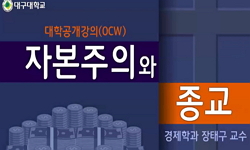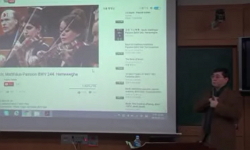기독교 예배에서 성찬예식은 초대 교회 이후로 매우 중요한 위치를 차지해왔다. 이 논문은 종교개혁가 칼빈이 예배의 중요한 부분인 성찬에 대해서 어떻게 이해하고 실천했는지를 살펴본다...
http://chineseinput.net/에서 pinyin(병음)방식으로 중국어를 변환할 수 있습니다.
변환된 중국어를 복사하여 사용하시면 됩니다.
- 中文 을 입력하시려면 zhongwen을 입력하시고 space를누르시면됩니다.
- 北京 을 입력하시려면 beijing을 입력하시고 space를 누르시면 됩니다.
부가정보
국문 초록 (Abstract)
칼빈의 성찬 이해를 위해서 이 논문은 종전의 논쟁, 즉 그리스도의 임재와 관련한 교리적 이해가 아닌, 칼빈이 실천한 성찬 예식의 내용과 그 의식에 담긴 신학을 예배학적으로 살펴본다. 즉, 칼빈이 제네바에서 실천한 의식을 구체적으로 기술하고, 그 실천에 담긴 특징을 역사적으로 살펴보며, 그러한 실천에 담긴 신학을 이끌어낸다. 칼빈은 성경에 근거해서 중세의 복잡한 성찬기도들을 폐기하고 성경과 함께 기능하는 이해하기 쉬운 방식으로 예식을 단순화시켰다. 이 과정에서‘떡과 잔’보다는 성령을 통해서 주어지는 성찬 의식의 효력을 강조했다. 그리고, 성찬 의식 자체에 머무르지 않고, 성찬이 지닌 하나님과 이웃에 대한 태도의 중요성을 강조했다. 현대 개혁주의교회는 칼빈이 원래 의도했던 성찬과 말씀의 균형잡힌 실천을 매주 실현할 것인지, 역사적으로 실천된 방식을 따를 것인지 결정해야 한다. 그리고 더 나아가 그가 제시한 개혁주의적 성찬 원리 곧 말씀과 성령 그리고 삶을 통합하는 성찬의식의 실천을 더욱 개발해야하는 과제를 지닌다.
기독교 예배에서 성찬예식은 초대 교회 이후로 매우 중요한 위치를 차지해왔다. 이 논문은 종교개혁가 칼빈이 예배의 중요한 부분인 성찬에 대해서 어떻게 이해하고 실천했는지를 살펴본다. 종교개혁의 한 부분으로서 칼빈은 중세의 성찬 의식 자체를 폐기하지 않았고, 오히려 자신의 개혁주의 신학에 대한 이해를 가지고 예배에서 성찬의 이해와 실천 방식을 새롭게 제시했다. 칼빈이 실천한 성찬의식은 자기 스스로 개발한 것이 아니라, 성경과 초대교회의 원리에 근거해서, 자신과 동시에의 부처와 파렐의 영향을 받아 경험한 것을 바탕으로, 이후 개혁주의 교회들의 모델로 개발된 것이다.
칼빈의 성찬 이해를 위해서 이 논문은 종전의 논쟁, 즉 그리스도의 임재와 관련한 교리적 이해가 아닌, 칼빈이 실천한 성찬 예식의 내용과 그 의식에 담긴 신학을 예배학적으로 살펴본다. 즉, 칼빈이 제네바에서 실천한 의식을 구체적으로 기술하고, 그 실천에 담긴 특징을 역사적으로 살펴보며, 그러한 실천에 담긴 신학을 이끌어낸다. 칼빈은 성경에 근거해서 중세의 복잡한 성찬기도들을 폐기하고 성경과 함께 기능하는 이해하기 쉬운 방식으로 예식을 단순화시켰다. 이 과정에서‘떡과 잔’보다는 성령을 통해서 주어지는 성찬 의식의 효력을 강조했다. 그리고, 성찬 의식 자체에 머무르지 않고, 성찬이 지닌 하나님과 이웃에 대한 태도의 중요성을 강조했다. 현대 개혁주의교회는 칼빈이 원래 의도했던 성찬과 말씀의 균형잡힌 실천을 매주 실현할 것인지, 역사적으로 실천된 방식을 따를 것인지 결정해야 한다. 그리고 더 나아가 그가 제시한 개혁주의적 성찬 원리 곧 말씀과 성령 그리고 삶을 통합하는 성찬의식의 실천을 더욱 개발해야하는 과제를 지닌다.
다국어 초록 (Multilingual Abstract)
Calvin articulated the simple pattern of the Reformed Eucharistic rite at Geneva according to his theological conviction: the Lord’s Supper cannot exist apart from the Word. Moreover, Calvin regarded the preaching of the Word and the observance of the sacrament as “distinguishing marks of the church.” With having this conviction, when reforming the medieval Mass, Calvin did not want to destroy the Eucharistic rite, rather he intended to appropriately develop the Eucharistic rite by adding the explanation of the meaning of Holy Communion for the communicant. In this respect, in practice, its frequency was crucial to Calvin’s service of the Word and Eucharist. Even though he did not succeed in practicing the Eucharist frequently, the clear and simple pattern of the service of the Word and the Eucharist was a successful aspect in that he manifested his theological understanding of the Communion rite as he desired. As a result, we can understand that even though he really intended to celebrate Communion every week, historically he did not practice that frequency at Geneva. The remaining question for Reformed churches when it comes to the frequency of the Supper is whether they should follow his intention (every week) or his practice (four times per year).
This paper analyzes Calvin’s Eucharistic rite after he came to Geneva the second time. The goal of this paper is to appropriately understand Calvin’s intention and practice of the Eucharist. In order to accomplish this goal, this paper first descr...
This paper analyzes Calvin’s Eucharistic rite after he came to Geneva the second time. The goal of this paper is to appropriately understand Calvin’s intention and practice of the Eucharist. In order to accomplish this goal, this paper first describes Calvin’s Eucharistic rite and traces its historical and cultural background. Secondly, this paper analyzes his understanding or the theology behind the rite. Thirdly, this paper evaluates and comments on Calvin’s Eucharistic rite in Geneva by looking into his own theological reflection on the rite, its actual practice, and its contributions and limitations for theology and practical ministry.
Calvin articulated the simple pattern of the Reformed Eucharistic rite at Geneva according to his theological conviction: the Lord’s Supper cannot exist apart from the Word. Moreover, Calvin regarded the preaching of the Word and the observance of the sacrament as “distinguishing marks of the church.” With having this conviction, when reforming the medieval Mass, Calvin did not want to destroy the Eucharistic rite, rather he intended to appropriately develop the Eucharistic rite by adding the explanation of the meaning of Holy Communion for the communicant. In this respect, in practice, its frequency was crucial to Calvin’s service of the Word and Eucharist. Even though he did not succeed in practicing the Eucharist frequently, the clear and simple pattern of the service of the Word and the Eucharist was a successful aspect in that he manifested his theological understanding of the Communion rite as he desired. As a result, we can understand that even though he really intended to celebrate Communion every week, historically he did not practice that frequency at Geneva. The remaining question for Reformed churches when it comes to the frequency of the Supper is whether they should follow his intention (every week) or his practice (four times per year).
목차 (Table of Contents)
- 1 Calvin’s Eucharistic Rite in Geneva
- 2 The Faith and Theology of Calvin’s Service of the Word and the Eucharist in Geneva
- 3 Evaluation of Calvin’s Eucharistic Rite and Theology
- 참고문헌
- 영문초록
- 1 Calvin’s Eucharistic Rite in Geneva
- 2 The Faith and Theology of Calvin’s Service of the Word and the Eucharist in Geneva
- 3 Evaluation of Calvin’s Eucharistic Rite and Theology
- 참고문헌
- 영문초록
- 국문초록
참고문헌 (Reference)
1 Kingdon, Robert, "“Worship in Geneva Before and After the Reformation.” In Worship in Medieval and Early Modern Europe" University of Notre Dame Press 2004
2 Luther, Martin, "“Confession Concerning Christ’s Supper.” In Luther’s Works Vol. 37 Word and Sacrament III" Fortress 1970
3 Calvin, John, "“Articles Concerning the Organization of the Church and of Worship at Geneva Proposed by the Ministers at the Council (Jan 16, 537),” Calvin: Theological Treatises" Westminster Press 1977
4 Luther, Martin, "“An Order of Mass and Communion for the Church at Wittenberg.” In Luther’s Works Vol 53 Liturgy and Hyms" Fortress Press 1965
5 Calvin, John, "Writings on Pastoral Piety" Paulist Press 2001
6 Calvin, John, "Tracts and Treatises, vol. 2" Eerdmans 1959
7 Bradshaw, Paul, "The Search for the Origins of Christian Worship" Oxford University Press 2002
8 White, James, "The Sacraments in Protestant Practice and Faith" Abingdon 1999
9 Senn, Frank, "The People’s Work: A Social History of the Liturgy" Augsburg Fortress 2006
10 Kingdon, Robert, "Registers of the Consistory of Geneva in the Time of Calvin, vol. 1: 1542-1544" Eerdmans 2000
1 Kingdon, Robert, "“Worship in Geneva Before and After the Reformation.” In Worship in Medieval and Early Modern Europe" University of Notre Dame Press 2004
2 Luther, Martin, "“Confession Concerning Christ’s Supper.” In Luther’s Works Vol. 37 Word and Sacrament III" Fortress 1970
3 Calvin, John, "“Articles Concerning the Organization of the Church and of Worship at Geneva Proposed by the Ministers at the Council (Jan 16, 537),” Calvin: Theological Treatises" Westminster Press 1977
4 Luther, Martin, "“An Order of Mass and Communion for the Church at Wittenberg.” In Luther’s Works Vol 53 Liturgy and Hyms" Fortress Press 1965
5 Calvin, John, "Writings on Pastoral Piety" Paulist Press 2001
6 Calvin, John, "Tracts and Treatises, vol. 2" Eerdmans 1959
7 Bradshaw, Paul, "The Search for the Origins of Christian Worship" Oxford University Press 2002
8 White, James, "The Sacraments in Protestant Practice and Faith" Abingdon 1999
9 Senn, Frank, "The People’s Work: A Social History of the Liturgy" Augsburg Fortress 2006
10 Kingdon, Robert, "Registers of the Consistory of Geneva in the Time of Calvin, vol. 1: 1542-1544" Eerdmans 2000
11 Jasper, R.C.D., "Prayers of the Eucharist: Early and Reformed" A Pueblo Book 1990
12 Thompson, Bard, "Liturgies of the Western Church" Fortress Press 1961
13 Calvin, John, "Institutes of the Christian Religion" Westminster Press 1960
14 Gerrish, Brian, "Grace and Gratitude, The Eucharistic Theology of John Calvin" Augsburg Fortress 1993
15 Bradshaw, Paul, "Eucharistic Origins" Oxford University Press 2004
16 Brilioth, Yngve, "Eucharistic Faith and Practice: Evangelical and Catholic" SPCK 1953
17 Calvin, John, "Calvin’s Ecclesiastical Advice" Westminster/John Knox 1991
18 Wallace, Ronald, "Calvin’s Doctrine of the Word and Sacrament" Eerdmans 1957
동일학술지(권/호) 다른 논문
-
Chronological Harmonization between the Two Creation Accounts in Genesis
- 한국개혁신학회
- 황선우(Hwang, Sun-Woo)
- 2011
- KCI등재후보
-
An Evaluation of William Wrede’s Hermeneutics
- 개혁신학회
- 이강택(Lee, Kang-Taek)
- 2011
- KCI등재후보
-
은혜의 수단인 기도로서의 시편 찬송에 대한 칼빈의 이해
- 개혁신학회
- 이은선(Lee, Eun-Seon)
- 2011
- KCI등재후보
-
- 개혁신학회
- 성호숙(Sung, Ho-Sook)
- 2011
- KCI등재후보
분석정보
인용정보 인용지수 설명보기
학술지 이력
| 연월일 | 이력구분 | 이력상세 | 등재구분 |
|---|---|---|---|
| 2024 | 평가예정 | 계속평가 신청대상 (계속평가) | |
| 2022-01-01 | 평가 | 등재후보학술지 선정 (신규평가) |  |
| 2021-12-01 | 평가 | 등재후보 탈락 (계속평가) | |
| 2019-01-01 | 평가 | 등재후보학술지 선정 (신규평가) |  |
| 2018-12-01 | 평가 | 등재후보 탈락 (계속평가) | |
| 2016-01-01 | 평가 | 등재후보학술지 선정 (신규평가) |  |
| 2015-12-01 | 평가 | 등재후보 탈락 (기타) | |
| 2014-01-08 | 학회명변경 | 한글명 : 개혁신학회 -> 영문명 : 미등록 -> The Society of Reformed Theology |  |
| 2014-01-08 | 학술지명변경 | 외국어명 : 미등록 -> Korea Reformed Journal |  |
| 2013-01-01 | 평가 | 등재후보학술지 유지 (등재후보2차) |  |
| 2012-01-01 | 평가 | 등재후보 1차 PASS (등재후보1차) |  |
| 2011-01-01 | 평가 | 등재후보학술지 유지 (등재후보1차) |  |
| 2010-01-01 | 평가 | 등재후보 1차 FAIL (등재후보2차) |  |
| 2009-01-01 | 평가 | 등재후보 1차 PASS (등재후보1차) |  |
| 2007-01-01 | 평가 | 등재후보학술지 선정 (신규평가) |  |
학술지 인용정보
| 기준연도 | WOS-KCI 통합IF(2년) | KCIF(2년) | KCIF(3년) |
|---|---|---|---|
| 2016 | 0.44 | 0.44 | 0.43 |
| KCIF(4년) | KCIF(5년) | 중심성지수(3년) | 즉시성지수 |
| 0.38 | 0.38 | 0.59 | 0.13 |





 스콜라
스콜라






